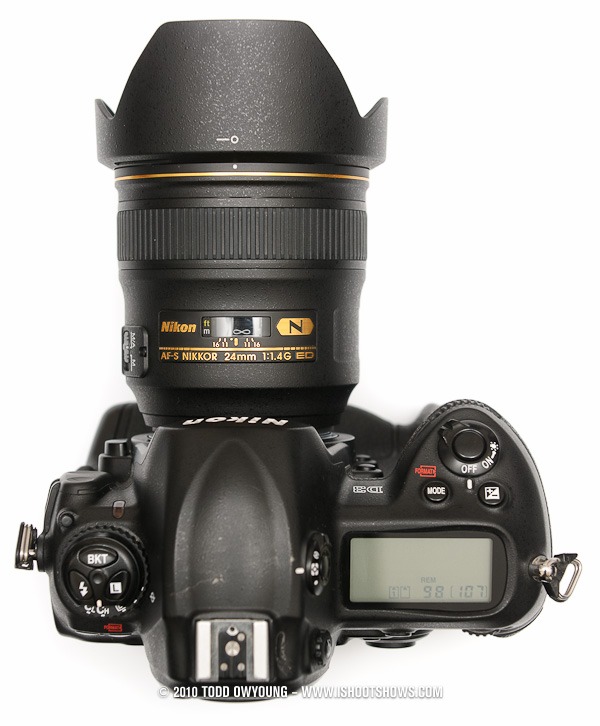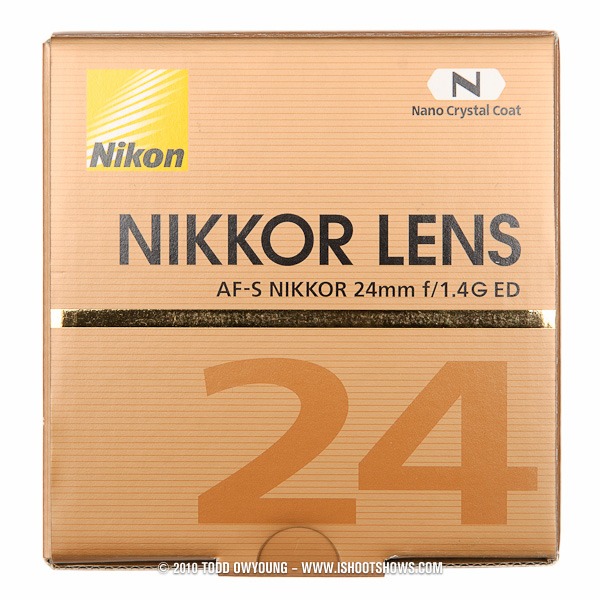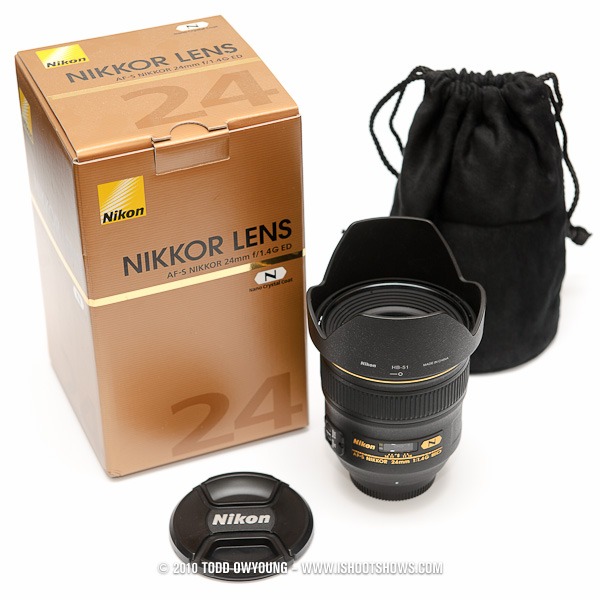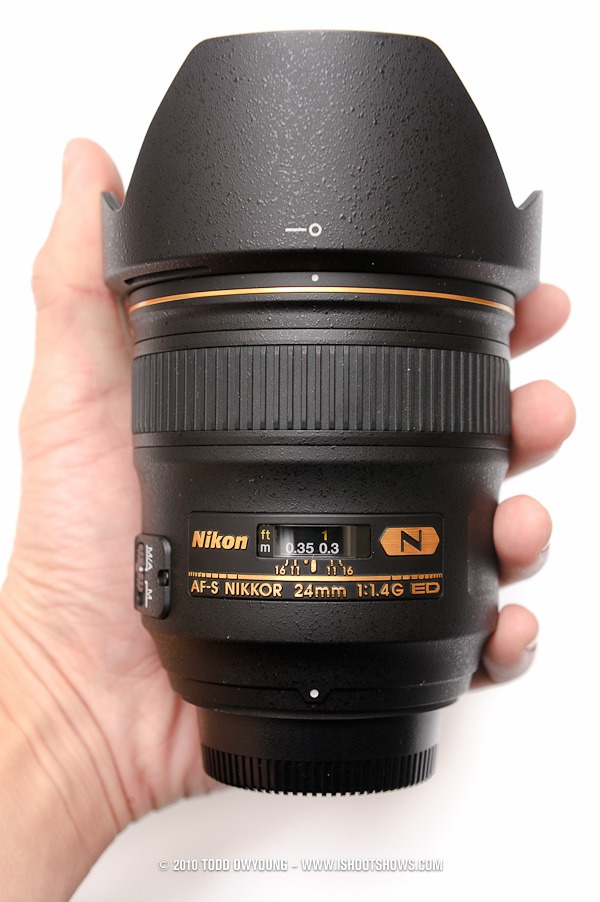While Canon users have been overpaying for beautiful fast primes for years, Nikon shooters have long been denied this privilege, with a distinct lack of “modern” choices in the arena of fast glass. In particular, many have lamented the absence of fast, wide-angle option, especially after the discontinuation of the Nikon 28mm f/1.4 AF-D in 2006.
With the introduction and release of the Nikon 24mm f/1.4G AF-S, I have news for you. Nikon users: It's time for you to shut up. Dry your tears, open up your wallet and get ready to empty it out, because the lens you've been waiting for is finally here. And it rocks.
My extensive review of this fast, wide-angle lens after the jump.

Support These Reviews
The Nikon 24mm f/1.4G AF-S tested in this review was provided by B&H, where I personally buy all my camera gear. If you find this review helpful, please consider buying your next photo gear purchase from B&H, Amazon.com, or any of my other my affiliate links.
To learn how you can help support www.ishootshows.com, visit the page Buy Yourself Something Nice. Now with that out of the way, let's get to the review.
Lens Specifications
| Focal length: | 24 mm |
|---|---|
| Maximum aperture: | f/1.4 |
| Minimum aperture: | f/16 |
| Lens construction: | 12 elements in 10 groups (with two ED glass and two aspherical lens elements, and Nano Crystal Coat) |
| Angle of view: | 84° (61° for Nikon DX format) |
| Minimum focus distance: | 0.25 m |
| No. of diaphragm blades: | 9 pcs. (rounded) |
| Filter/attachment size: | 77mm |
| Diameter x length: | Approximately 83(dia) x 88.5 mm (extension from the camera's lens-mount flange) |
| Weight: | Approximately 620 g |
| Supplied accessories: | 77mm Snap-on Front Lens Cap LC-77, Rear Lens Cap LF-1, Bayonet Hood HB-51, Flexible Lens Pouch CL-1118 |
Optical Design
If this optical design doesn't get you excited – well, you're probably not a photo nerd. But aspherical elements, ED glass, and Nano Crystal Coating all smack of enough promise to make things interesting even before you twist this onto your camera.
MTF Chart
This is a good looking MTF chart. What we can see from this is that contrast is excellent, and even more remarkably so because this is the performance wide open. Sharpness at the center of the lens is very good, with a slide degradation out toward the edges. Again, this is all at f/1.4 – just a taste of what's to come when you stop down.
What's In The Box
The new 24mm comes with all the standard goodies – a soft lens pouch, lens hood, and all the associated literature you'd expect.
The lens pouch is tall enough that you can store the lens standing up with the hood attached. This is the same pouch that ships with the Nikon 85mm f/1.4G and Nikon 24-120mm f/4 VR, so given the shorter lens hood, the pouch is actually a little large for this lens.
Key Features
As per Nikon's own product page for the new 24mm f/1.4G:
- A fast, wide-angle lens with a fixed focal length of 24mm at the maximum aperture of f/1.4
- Fast lens with a maximum aperture of f/1.4 that allows users to capture images with beautiful blur characteristics
- ED glass and aspherical lens elements are utilized for a new optical design that achieves high resolution and good balance in terms of aberration for pleasing blur characteristics
- The adoption of Nano Crystal Coat effectively reduces ghost and flare
- Quiet focusing with built-in Silent Wave Motor (SWM)
- Two focus modes selectable – M/A and M
Fast f/1.4 Aperture
Silent Wave AF-S Motor
As you may know, Nikon has been slowly updating their stable of fast prime lenses. Previously, Nikon users have relied on older models like the Nikon 85mm f/1.4 AF-D and Nikon 50mm f/1.4 AF-D, both of which are driven by the older system of an AF motor built into the camera body. This wouldn't be an issue, except that Nikon has recently created a schism in their lineup, reserving this in-body motor for more expensive DSLRs and leaving many users without an option for fast, AF prime lenses.
With the AF-S updates to the 85mm f/1.4 and all of Nikon's other new primes, the AF motor is built into the lens, so they are usable on any current Nikon DSLR.
Nano Coating
I've said it before and I'll say it again. I love Nikon’s Nano Crystal Coating. It's like bacon – it just makes everything better. Nikon's new proprietary coating may just be marketing hype, but I have to say it's working, because every lens that's been spanked with Nano has delivered beautiful color and contrast, even in tough lighting situations.
On paper, Nano coating is a multi-coating that reduces ghosting and flare. But together with the new optical designs Nikon has been rolling out, this new generation of lenses just has a fantastic quality that I love. Beautiful, natural contrast that's more like looking at reality than an image.
“Blur Characteristics”
The funny thing about Nikon repeatedly mentioning “blur characteristics” is that, in an age of rampant marketing hype, they're actually pretty much right. Thanks for the fast f/1.4 aperture, even at 24mm this lens is capable of producing very nice shallow depth of field under the right circumstances, especially with the minimum focusing distance of 0.25-meters.
Design & Usability
Ergonomics
This lens has perfect ergonomics. As good as the new 85mm f/1.4G is in terms of balance and tactile joy, the 24mm f/1.4G is even better. Both lenses are almost identical in length and size, but the 24mm's barrel tapers more, for a pleasing, more humanistic user experience.
The new 24mm f/1.4G AF-S balances beautifully on either a full-sized camera like the D3s or a smaller body like the D700.
Controls & Switches
As a prime lens, there's obviously no zoom ring on this lens – just a single knurled ring for manual focus. Curiously, but the focusing ring on the 24mm f/1.4G is even smoother and nicer to use on than the 85mm f/1.4G, which is where you'd think Nikon would have put the best operation.
The level of smoothness is the same between the two new f/1.4 lenses, but the 24mm features a more damped and well-weighted operation. For my use, this is even closer to the old manual focus AI and AI-S lenses I used to use.
The switches on the side of the 24mm f/1.4 are the standard M/A -M switch to toggle between Autofocus with Manual override or Manual focus-only.
Size Comparison: 24mm vs 85mm
Side-by-side, the Nikon 24mm f/1.4G and the Nikon 85mm f/1.4G are almost identical in the size of the lens barrel – where the two differ enormously is in the size and presence of their respective lens hoods.
Lens Hood
The lens hood for the new 24mm features a friction lock, so it just twists on and snaps into place. For my use, the scalloped hood has a small enough footprint that there's almost no reason to remove it when you're not shooting (unlike say, the Nikon 24-70mm f/2.8 or Nikon 70-200mm f/2.8).
Build Quality
The new 24mm features great build quality – a big step up from its little brother the 50mm f/1.4G AF-S, and the same solidity as the 85mm f/1.4G AF-S.
Just as you'd expect, the lens features the pro-standard filter size of 77mm, just like the 85mm f/1.4G, Nikon 24-70mm f/2.8, and Nikon 70-200mm f/2.8 VR II.
As a prime lens with internal focus (IF), there are very few moving parts on the exterior of this lens design; it's a heavy, solid design. I can't say that it feels like $2,000, but it shoots like it. Let's get to the performance of this lens.
Performance – AF Speed & Precision
I have to admit, I was genuinely surprised and pleased by the speed of AF on this lens. To date, I'd say that the 24mm f/1.4G focuses the fastest out of all the prime lenses I've used on the Nikon D3, and on par with the seemingly psychic focusing of the Nikon 24-70mm f/2.8.
Of course, speed is nothing without precision. I found that once this lens is fine-tuned to your camera body, AF is extremely precise, even at wide apertures.
One thing you do have to consider is that due to the combination of a wide field of view and the shallow depth of field possible with this lens, accurate AF calibration is a must. In addition, careful AF is necessary, since this combination of a wide aperture and broad FOV mean that the AF sensors of your DSLR can “catch” on other targets beyond your subject if you are not careful.
The reason for this is that the actual AF sensors of your DSLR actually extend beyond what's indicated in the viewfinder.
Performance – Color & Contrast
You can skip this part of the review. The Nikon 24mm f/1.4G AF-S has the same great color and contrast of all of Nikon's professional lenses. Don't worry about the color and contrast performance of this lens – worry about composition, the decisive moment, and all that other stuff.
Performance – Defocusing Quality
Normally the defocusing quality of a wide-angle lens isn't something you'd have to be concerned about. Thanks to the fast f/1.4 aperture, however, subject isolation and depth of field are strangely a very real-world issue with the Nikon 24mm f/1.4G.
There's good news and there's bad news.
The Bad News: The circle of confusion the 24mm f/1.4 draws is prone to a slight harshness to the edge.
The Good News: There is actually some genuine blur to look at with this lens, which for a wide-angle is amazing. That, and despite what the internet might tell you, a smooth defocusing character is not always ideal. In fact, I have to say that I prefer the extra “bite” in the defocused elements rendered by this lens.
Let's take a look at how the 24mm looks at f/2 in a real-world shot from a wedding shoot in NYC from last month.
Full Frame:
100% Crop – Center:
In this crop from near the center of the frame, you can see that the circle of confusion drawn for out-of-focus highlights is relatively neutral. Where we see a slight bias toward a harsher outer ring is in the white lettering, where the overlapping elements start to create added visual interest.
100% Crop – Edge:
In the crop from slighter farther toward the edge of the frame, we can see more of a very slight brighter ring for the defocused elements.
Here's another example image with an additional crop, this time at f/1.4.
Full Frame:
100% Crop:
Here in this f/1.4 sample, you can see that specular highlights are drawn with an even more pronounced edge effect. Personally, I love it. You may call it harsh – I'll call it shimmery.
If you wanted to minimize this effect, stopping down diminishes the edge emphasis in defocused highlights, as evident in the first sample and respective crops.
Due to the perspective distortion of the 24mm wide-angle, I find that the harder-edge of defocused elements actually draws more attention to the depth of field and create a heightened dimensional emphasis. Were the defocusing quality smoother, I think that this emphasis would get lost more easily due to the apparent size of the out of focus highlights in comparison to a telephoto image with shallow depth of field.
Performance – Chromatic Aberrations & Weird Stuff
Overall, I found that the 24mm f/1.4G seems very well corrected for purple fringing, with fringing occurring in only a handful of images made at f/1.4.
This 24mm does exhibit chromatic aberrations – again, most notably only at wide apertures and toward the extreme edges of the frame. Here's one example of CA and how to correct for this artifact.
Full Frame:
100% Crop:

Overall, correction in Adobe Lightroom 3 was a snap – the above image required a setting of -30 to the Red/Cyan Chromatic Aberration slider.
However, one other artifact that I have seen with the 24mm shot at wide apertures (f/1.4 or f/1.6) is a vertical ghosting – you can see this on the white cap to the plastic water bottle in the above crop. In the two instances I've seen of this effect, the “ghosting” is exhibited in very high contrast/blown out areas.
Image Performance – Sharpness
The 24mm f/1.4G AF-S is a tremendously nice lens in terms of sharpness. Remember when I told you to skip the Color & Contrast section? Well I take it back, so I'll just add it here.
Overall, one thing I noticed about this 24mm lens is that it has a very fine rendering. At wide aperture, the lens doesn't blow you away with contrast in the way it will stopped down. In terms of sharpness, the lens never disappoints, but this more delicate contrast rendition does mean that apparent sharpness is affected when shooting at wide apertures.
To get the most out of this lens, I recommend a very fine sharpening Radius in Lightroom and a high amount of Amount and Detail in the sharpening dialogue.
Full Frame:
This sample was shot at f/1.6 with the Nikon 24mm f/1.4G AF-S and the Nikon D3 at ISO 200.
100% Crop:
In the above crop, I sharpened using the following settings in Lightroom 3:

As you can see in the crop, there's plenty of detail, with individual hairs and the subtle textures of the skin captured beautifully – all at f/1.6. Needless to say, the lens offers all the crystalline detail you could want across the frame when stopped down.
Samples – Wedding Photography
I loved shooting a recent wedding with this new 24mm. The fast f/1.4 aperture was fantastic to use for giving a more unique spin to wide-angle shots, allowing for a subject isolation that is normally associated with a telephoto lens.
In particular, I loved being able to shoot between f/1.4 and f/2 to make the most out of this unique combination of shallow depth of field and a wide perspective.
For my shooting, shooting at f/2 and wider is where the Nikon 24mm f/1.4 really shines – stopping down to f/2.8 and below, the look becomes much more pedestrian. And, as they say: if you got it, flaunt it.



For me, this last image sums up the unique abilities and offerings of the Nikon 24mm f/1.4G AF-S. This image was basically lit entirely by candle light, with a little fill from the fading blue hour and a little twinkle from the lights of NYC.
Samples – Music Photography
Below are real-world samples of the Nikon 24mm f/1.4G kicking butt for me in the arena of music photography. For all the concert photography below, it's worth noting that the lighting was generally so low that they could only be made with a fast lens like the 24mm at extremely wide apertures or a silly camera like the Nikon D3s at ISO 12,800 or above.
I generally shoot a trio of f/2.8 zooms for my live music photography and shoot around ISO 3200, so when I pull out the primes, it's only in the very worst of light where an extra two-stops of light is essential.
All samples below were shot on the Nikon D3 and D700.


Reasons You Want This Lens
1) Telephoto Isolation in a Wide-Angle
For me, the top reason to have the Nikon 24mm f/1.4G in your bag is that it gives you dramatic isolation in a wide-angle lens, thanks to the very shallow depth of field possible. It's this unexpected sense of separation of the subject from the background that really makes this lens capable of delivering unique images. For wedding photography or environmental portraiture, this lens is amazing.
2) Shoot in the Dark with f/1.4
Speed kills. Speed also saves. The beautiful thing about a 24mm f/1.4 lens is that it practically lets you shoot in the dark. Since it's a wide 24mm lens that's perfectly balanced on a D700 or D3 alike, you can handhold the Nikon 24mm f/1.4G at ridiculously low shutter speeds. Pair this with the high ISO performance of any current DSLR, open that eye to f/1.4, and your world just got brighter.
3) Beautiful Defocusing
This lens produces harsh defocused elements when shot wide-open. And guess what: it's beautiful. While the character smooths out when stopped down, shooting this lens wide open creates a unique, 3-D pop that I love.
Here are two of my favorite images I made with the Nikon 24mm f/1.4G AF-S that I think sum up these unique offerings – both shot wide open at f/1.4:
Summary
For any Nikon shooter who has ever lusted after the Canon 24mm f/1.4L, your day has come. After shooting with the Nikon 85mm f/1.4G, Nikon 50mm f/1.4G, and now the Nikon 24mm f/1.4G, I don't have any doubt that Nikon shooters now have access to the very best primes available.
The Nikon 24mm f/1.4G represents a small coup for Nikon users, who finally have a fast wide-angle prime Nikkor. More than that, the new 24mm delivers fantastic quality – so good things do come to those who wait.
To me, this new 24mm lens has an interesting dichotomy. On the one hand, there's the pure utility of it, with extremely fast AF response and a very bright f/1.4 aperture that is capable of shooting in all the available darkness you care to throw at it. On the other, this lens had such a beautiful character when shot below f/2, the unique character of this lens is reason enough for it to exist for me.
The allure of the 24mm is in part due to the traditional notion that wide-angle lenses are associated with a maximum of depth of field, a standard that this fast f/1.4 prime intensely confronts. While shooting with it, I found myself shooting at as wide of an aperture as I dared to draw out the 24mm f/1.4's intriguing combination of wide-angle and shallow depth of field.
Furthermore, the 24mm f/1.4G AF-S is a perfect example of a lens where a strong rendition of defocused highlights is not only acceptable, but desirable. Just as any chef wouldn't rely on singular flavor or taste for every single dish, so too should photographers draw on a range of tools capable of delivering different characteristics. So for all the creamy bokeh fanatics, you better learn to eat bitter – you'll love it.
Of course, there's a lot to love about this lens. Between the smooth contrast, effortless sharpness, and creative possibilities of a fat-aperture wide-angle, the only thing not to like is the price.

Where To Buy – Recommended Retailers
The Nikon 24mm f/1.4G AF-S tested in this review was provided by B&H in NYC. If this review and other content on www.ishootshows.com was helpful to you, please consider supporting this site and purchasing your photo equipment any of the links in this review, my support page, or elsewhere on my site.
- Nikon 24mm f/1.4G AF-S @ B&H
- Nikon 24mm f/1.4G @ Amazon.com
If you do buy through B&H or any of my affiliate links, drop me a line! I’d love to hear about what you picked up. B&H is where I personally buy the vast majority of my gear, and I’m looking forward to bringing you more reviews thanks to their equipment loans.
Questions? Comments?
Do you have questions about the new Nikon 24mm f/1.4G AF-S? Let me know.
If you have this new prime, what do you think of it? Chime in and have your say!





































































